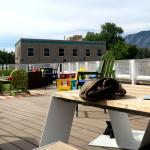Photo: St. Sergius cathedral
Photo and description
On the left bank of the Sutoloka River, at the foot of the Sergius Mountain, at the end of the sixteenth century, a temple was built by Moscow archers, who especially revered St. Sergius of Radonezh. On the site of the cathedral building that exists today, there once stood two wooden churches, which burned down successively in 1774 and 1860.
In 1868, a new wooden building of the Sergius Church, built on a stone foundation, was consecrated. The architecturally modest temple, reminiscent of a rural parish church, was loved and revered by the townspeople. In 1933, after the destruction and closure of all cathedrals and churches, the small temple became the cathedral of the Ufa diocese. From 1937 to 1942, the clergy of the Sergius Cathedral were arrested and shot (as a result of which virtually no services were held), but the temple “mercifully” remained open to parishioners. Throughout the Soviet years, the St. Sergius Cathedral remained the center of Orthodox life in the Ufa region. In 1942, priests, former prisoners of the camps, returned to the church, and in 1945 the temple received gratitude for raising funds for the needs of the country's defense.
These days oldest building The temple, which has undergone major repairs more than once with the replacement of wooden elements of the building with more durable material, decorates historical center Ufa. In the church there are icons with particles of the relics of St. Sergius of Radonezh, St. Nicholas the Wonderworker and other saints. On the territory of the temple there is a source of holy water and a font, as well as the tomb of the governors of the former monastery (popularly called a cave). Since 2000 On the day of the Holy Trinity, a five-day religious procession (dedicated to the founding of the city in 1574) around Ufa begins annually from the temple, with visits to suburban churches.
St. Sergius Cathedral is located on Bekhtereva Street, 2, not far from the Posadskaya Hotel. The parish church has a modest appearance, but is one of the main centers of Orthodox life in the Ufa diocese.
Churches have stood on the site of the current temple before. The first was erected in honor of Sergius of Radonezh at the end of the 16th century and, having survived the difficult years of the Peasant War, burned down in 1774. The next church existed for almost a hundred years, and after it, in 1868, the current cathedral was built.
Among the 720 churches in Ufa, St. Sergius Church is the only one that was never closed in the 30s and 40s. last century. However, services were not held for several years due to the total arrest of the Ufa clergy.
The iconostasis for the church was made by the famous carver Trapeznikov in 1894 with funds allocated by the merchant F. E. Chizhev. Several icons were painted for the church, the creator of which was M. V. Nesterov. The temple contains many icons with particles of the relics of saints.
While staying at the Posadskaya Hotel, you can visit several Orthodox churches located near the hotel.
The Church of St. Sergius of Radonezh is located a few tens of meters from the intersection of the Sutoloka and Belaya rivers. This is a small but very expressive temple, built in 1868. The predecessor of the Sergius Church was a church founded in the 16th century by archers and gunners, who were sent to Ufa to guard the city fortress.
The first Church of St. Sergius of Radonezh burned down in 1774 and was restored to its original location three years later. But to end of the 19th century century, this temple fell into disrepair, and it was decided to dismantle it and transport it to one of the surrounding villages. The new church was also built of wood, but, unlike its predecessors, it rested on a stone foundation. It is this building that appears to our eyes now. The carved iconostasis is made in the best traditions of church art. The main shrine of the temple was the ancient icon of St. Sergius of Radonezh. It was this icon that was blessed by Supreme Admiral Kolchak, who came to Ufa in May 1919.
The 1930s were marked by the closure of many churches, and the Sergius Church began to serve as the Cathedral in 1933. After the entire church clergy, headed by the bishop, was arrested in 1937, no services were held, and watchmen and cleaners kept order. In 1943, the church was opened again, and literally the next year the Ufa Archbishop received a telegram from I.V. Stalin with gratitude to the parishioners of the Sergius Church, who collected a large sum for the USSR Defense Fund.
The architecture of the church is quite modest - the building is made in a simple style with elements of classicism, forming a single ensemble with a refectory and a bell tower. The single head rests on an octagonal drum. The openings on the sides of the drum were once glazed, but they are now sealed.
St. Sergius Cathedral is located in a picturesque place - on the banks of a river with beautiful name Pine. On the territory of the cathedral there is now a bell tower and two churches: the Central one, which has two altars, the first consecrated in honor of the Dormition of the Mother of God, the second in honor of St. Sergius of Radonezh and the Church of Seraphim of Sarov. The bell tower building also houses a gate temple dedicated to the icon of Our Lady of Tikhvin.
Story
On the site of the St. Sergius Cathedral there was once monastery. The first mentions of it date back to the end of the sixteenth century, when Tsar Fyodor Ioannovich transferred the Tim River into the possession of the monastery. About fifty years later there was a big fire in the monastery, all the buildings burned out. They began to build the Sergius Church on the site of the monastery; the temple was consecrated in 1664. A little later, the Tikhvin church-bell tower was built.
In 1764, the monastery was closed by decree of Catherine II, but the churches remained operational until 1938, when the Cathedral was closed by decision of the city authorities.
During the war, the Sergius Church Bell Tower was badly damaged. In 1948, the buildings were recognized as architectural monuments, restoration work began, after which the Cathedral was returned Orthodox Church. Even in Soviet times, divine services were held in churches.
Current state
All buildings of St. Sergius Cathedral are in good condition. Sergievskaya and Tikhvin churches represent a single architectural complex.
The St. Sergius Church has been preserved almost in its original form. It is a unique architectural monument of the seventeenth century. As for the Tikhvin Church, it is one of the few surviving bell-tower churches that were erected in the seventeenth and eighteenth centuries.
Shrines of the Temple
Important Orthodox Shrines are kept in St. Sergius Cathedral:
- These are icons with particles of the relics of Sergius of Radonezh, Nicholas the Wonderworker, Tikhon of Zadonsk.
- Not far from the Temple there is a holy spring of St. Sergius of Radonezh, with a chapel and bath built above it.
- The place of worship of believers is also a cave-tomb in which the relics of the monastery inhabitants rest.
How to get to St. Sergius Cathedral
You can get to the St. Sergius Cathedral in Livny from Orel or Kursk by train.
Temple address: Livny city, Sergius Bulgakov Square, building 15.
Schedule of services
Divine services are held daily in the Temple:
- IN 8-30 Divine Liturgy;
- IN 18-00 Evening Worship.
On Sundays, an additional Liturgy is held at 6-30 am.
The schedule of services may change during important church holidays. The times of services can be found on the official website of the Cathedral.
Photos
The cathedral is an important architectural heritage site. His photographs can be found in specialized reference books and guidebooks. The first photographic images of the Cathedral of St. Sergius date back to the very beginning of the last century. Comparing old photos with modern ones, you can see that the Cathedral has almost completely preserved its original appearance.




